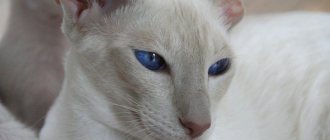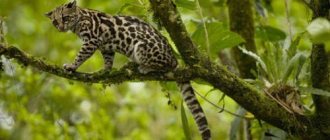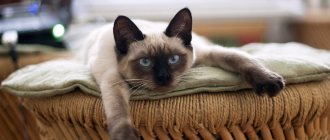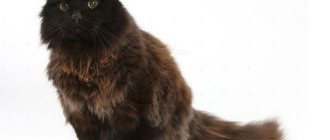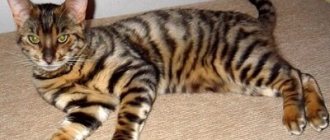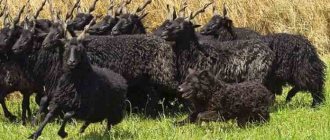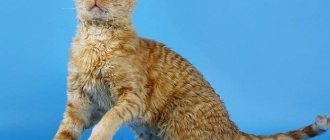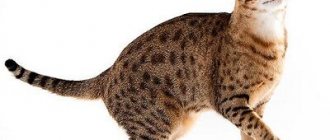The spotted cat is a breed whose roots go back to the world of wild animals. The pattern in the form of spots was inherited by modern spotted pets from ancestors living in natural conditions and forced to camouflage. Spotted cats, in addition to their appearance, inherited character traits from their ancestors: fearlessness, independence, mobility. Such animals do not require special care and attention from the owner, so they can be owned by those who are often absent from home.
It must be said that many of the modern spotted cat breeds are bred artificially. This may affect their health: stomach weakness and some genetic diseases are possible.
The most popular breeds of spotted cats are the Bengal, Scottish Fold, Californian Radiant, Ocicat, and Australian Smoky.
Bengal cat
The breed was obtained by crossing an outbred cat with a wild leopard. The breed was bred by geneticist D. Mill. The color scheme of Bengal cats' fur coats is very variable, because animals of different appearances were involved in the breeding of the breed. Typically, the Bengal's fur has a gray or brown tint, and the top of the coat is decorated with dark oblong spots.
The ears of a Bengal cat are oblong in shape. The eyes are almond-shaped and large. The neck is quite long, the body is elongated. The tail is medium, rounded at the end. The coat is short.
Spotted Bengal cats are graceful, sociable, and intelligent. Many are trainable. Despite their wild roots and penchant for hunting and swimming, they do not show aggression. But they may well bring prey for the owner, laying it at his feet.
Pixie – bob
These breeds are of American origin and acquired artificially.
When making such breeds, scientists wanted them to look like wild lynxes. They are large in size, and the ears have tassels like those of lynxes, which is what the emphasis was placed on. Scientists who produced spotted pets claim that they have genes from wild animals. But the DNA test did not show this.
In the eighties, a kitten was born for the first time, which was an exact copy of a wild lynx. And in 1995, this breed was officially registered. Animals of the Pixie-Bob breed are very rare, their paws are multi-fingered, and their eyes are wild. This breed is distinguished by its originality and truly powerful body. They have a wild posture and a freedom-loving character.
Cats of this breed are very smart and calm. They are not aggressive, but are wary of new people. From their appearance it seems that they are about to scratch you, but this is only at first glance. They are good cats and are not capable of such nonsense. They respect their masters and always obey them. They love communication and active games. You will be glad to have such a pet.
“If you breed them with a cat, they can bring no more than three kittens.”
Scottish fold cat
The Scots Fold can be of any color, including spotted, harlequin, and brindle. The spots are united on the back into one long dark stripe stretching along the body.
The Scottish Fold cat has an unusual ear structure - they are curved down and forward. Kittens are born with straight ears, and by the age of one month their ears take on their specific configuration. If the ears remain straight, then the animals belong to the Scottish Straight breed.
The Scottish breed of cats, including spotted ones, are distinguished by the round shape of their head, muzzle, and eyes. The nose is wide and short. The body is covered with dense, soft, short hair, which can have different color options.
British cat
British wool can be either plain or have different patterns. There are three types of patterns on the fur coat of these animals:
- Tabby;
- Spotted;
- Marble.
British cats become attached to their owners, but behave reservedly around strangers. They are very hard to touch, and it will take a lot of time to earn their trust and get in touch with them.
The British are mannered, aristocratic, and proud. Behind her sweet appearance and chubby cheeks lies a complex inner world.
Cheeto
For domestic cats, these are quite large animals - their weight ranges from 6.5 to 10 kg. The name of the breed suggested to the creators the gentle nature of these cats: they are obedient and friendly companions who love to “talk” with their owner and receive another portion of care and affection from him.
They inherited their wonderful character from their parents – purebred Ocicat and Bengal cats. Chitos are very attached to their owners; being with them is always interesting and fun. These wonderful cats have shiny, short and thick fur that feels like velvet. The fur coat can be of several colors, but there must be solid or individual spots in the form of rosettes.
California shining cat
This spotted cat is a breed created in 1976 in California. 5 years earlier, screenwriter Paul Casey traveled to Tanzania, where he learned about large-scale poaching of leopards. He set out to create a breed of domestic cats that looked like a leopard. His goal was to eradicate the desire among people to use the skin of these animals for clothing, because the fur of a leopard is so similar to the fur coat of a pet.
The California shining cat really resembles a leopard, not only in color, but also in many other characteristics. For example, their demeanor, grace and muscularity of the body were inherited from their wild ancestors.
Representatives of this breed tend to bend their paws at right angles, as if the animal is preparing to jump. This finally reveals the predatory roots of the California radiant.
The spots on the body of representatives of this breed can be of various shapes - triangle, oval, square, circle.
Savannah
A very elegant, graceful, rather large cat on high legs, with a small head on a long graceful neck, and huge, high-set ears. Savannahs are very smart, active and friendly cats.
This breed, like the Bengal, was bred through interspecific crossing (domestic cat and African serval). But, unlike the Bengals, no one was going to take them out. It all started with the fashion for servals in the 80s in the USA, and the unusual spotted pet could be bought in one of the nurseries. In one such nursery, an accidental mating of the owner's cat and a breeding serval occurred, from which a female kitten was born, named Savannah. She could not help but interest the breeders, and after some time it was decided to create a new breed, named after its first representative.
Australian smoky cat
The homeland of this cat is Australia. The breed appeared as a result of selection of Abyssinian and Burmese breeds. The cat is called smoky because its fur has a characteristic shade. The colors of the fur coat can be different - from bluish to peach. The spots are distinguished by ticking.
This cat's eyes can be different shades of green. The ears are wide, straight, slightly rounded at the ends. The cat itself is medium in size.
The Australian Smoky has a calm temperament, friendliness, and sociability. She does not tend to show her claws, so even small children can play with her. By the way, this cat loves babies very much. In relations with other animals living in the house, he also shows tolerance.
Ocicat
This breed does not have savages in its pedigree. Her ancestors are Siamese and Abyssinians, which were later crossed with American Shorthairs. The birthplace of the breed is the USA.
Externally, the animal resembles a wild ocelot, which is why the breed was given the name “Ocicat”.
The animal's fur is dotted with spots located on a plain base. The main background of the coat can be different - from blue to brown. The fur is short.
The Ocicat's head is medium in size, its muzzle is oblong. The ears are round and large. The eyes are expressive, almond-shaped. Their color can be any except blue.
By nature, Ocicats are extroverts. They are active, sociable, and love to have fun. They are able to find a common language with all family members, but they choose only one owner.
Hyena.
Small predators live in Africa and prefer to be in a pack. They are dangerous not only for mammals, but also for travelers who may encounter a hyena during their trip.
Spots on the fur help in hunting; with their help, animals externally merge with the ground and stones. The color allows them to be invisible to the victim and wait for the right moment to attack. Predators are difficult to spot in nature when they move around. There are few spotted hyenas left on the planet; the species is listed in the Red Book.
Toyger
The Toyger is a breed for those who would not mind having a tiger in their home. Representatives of this breed really resemble wild tigers, but in a mini version. They have a muscular body, brindle color, and short dense hair. However, their disposition is not at all predatory: they are very affectionate and friendly, like diligent pets. Translated, “toyger” means “toy tiger.”
Toygers are smart and highly trainable, and can be trained. They are sociable and playful and love to have fun. Find a common language with most people and animals.
They choose a master for themselves, to whom they are endlessly devoted. At the same time, the toyger is unpretentious and does not require increased attention to itself. Therefore, this breed is perfect for those who often leave the house.
The most popular spotted breeds of domestic cats
The tabby color is also found in breeds bred without crossing with wild cats.
Ocicat
In appearance it resembles the brightest cat in the world, Ocelot, and got its name in honor of him. Although it has no relationship with a wild cat, but was obtained by crossing a Siamese and Siamese-Abyssinian mestizos.
By its temperament, the Ocicat is a cheerful and playful pet, loyal and affectionate, sociable and loving.
The colors vary in color, but always with spots.
Read more in the article about Ocicats.
Egyptian Mau
Descended from common street cats of Cairo. Exported to America in the fifties of the last century. One of the oldest natural breeds in the world.
The color of the short, dense coat can be different - silver, bronze, smoky, pewter. But always a tabby - and only a dark spot.
A distinctive feature of his appearance is the “scarab” mark on his forehead and the black “eyeliner” of his expressive green eyes.
This small, muscular and very active cat has a balanced and independent character. She is attached to people, does not like loneliness, and is friends with all pets. Loves to talk with family members. The sounds that the Mau makes are not always like meowing, but resemble the “mumbling” of a person.
And you can learn more about this cat by reading the article about the Egyptian Mau on our portal.
Pixiebob
The Elf with the Short Tail was developed in the United States in 1985. The exact origin of the breed has not been determined; there is a version that wild cats participated in the selection, but this has not been confirmed by anything.
The pixie bob is characterized by the appearance of a lynx with tufted ears and a short tail. Polydactylism is common. The short or semi-long coat is always tabby in color - with spots or “rosettes”.
In their devotion to humans, these cats resemble dogs. Very calm, attentive and observant pets are friendly and love to play with children. They swim excellently, climb trees, hunt, “talk”, making beautiful curling and chirping sounds. They get along well with other pets, but are always leaders.
British Shorthair and Scottish Fold cats
The British and Scottish Fold are essentially different types of the same breed, although they are registered separately in feline systems. These are some of the most popular and oldest domestic breeds in the world.
By nature, these pets are self-sufficient, almost always phlegmatic. They like to sleep, but are not fans of active pastime. They are attached to people, love and do not offend children. Unpretentious and calm.
The colors of these cats are varied, spotted colors are very common.
American Shorthair (Kurzhaar)
This breed developed from its European relatives, who migrated with humans to America. A group of breeders began working on the approval of the variety at the beginning of the twentieth century.
The most famous color is the silver tabby - bright black, rather large spots on a light gray background.
The character of the American is called the “golden mean”, the cat is calm, does not require constant human attention, is moderately active and very devoted to the owner and all household members.
European Shorthair
The spotted color of this oldest breed is widely popular. The oldest European native variety was registered and presented to the public only in 1982.
A kind, energetic animal is deeply devoted to humans, willingly plays with children and at the same time never loses its hunting instincts.
Siberian
This natural oldest Russian breed most likely descended from Oriental cats brought to Siberia by merchants.
Animals with long hair and a thick undercoat are excellent hunters and have an independent and calm character. They are sincerely devoted to the owner and all household members, but do not like attention and affection imposed on them.
Among the many colors of Siberians, tabby is common.
Maine Coon
The raccoon cat is the pride of Americans. This natural breed has long been in the lead as the largest. The size of an adult cat (length with tail) reaches one and a half meters and weighs sixteen kilograms.
This pet is calm and undemanding, friendly and devoted to humans. But at the same time, like its ancient wild ancestor, it is an excellent hunter.
The colors of the coon are varied, spotted is quite popular.
Read more in the article about Maine Coons.
Serengeti
There are only a few hundred representatives of the Serengeti breed on the entire planet. Their homeland is America. The breed was developed not so long ago - in the 1990s. To create the Serengeti cats, matings were carried out between a Bengal cat and an Oriental shorthaired spotted cat.
Visually, the Serengeti is similar to the predatory servals, although they are not related. Its wild appearance combined with a non-aggressive character makes this cat surprisingly attractive.
The Serengeti has a medium-sized body that is athletic and athletic. Males are much larger than females. The tail is wide, its tip is black. The eyes of the Serengeti are large, widely spaced, and honey-colored.
How to embrace the immensity: the main varieties of cat colors
Diversity is diversity, but no one has canceled systematization. Therefore, all possible colors of cats were divided into several groups.
Table: main groups of cat colors
| Color group | General characteristics of the color group | Colors included in the group | Description of color |
| Solid colors | All hairs are well dyed to the roots, without patterns or any stains |
|
|
| Silver colors | A certain area of each hair is bleached white |
|
|
| Acromelanistic colors (colorpoint) | Body slightly colored, light (from white to cream); paws, tail, muzzle and ears are darker. |
|
|
All tabby, shaded and chinchilla colors are grouped together as agouti colors because it is the agouti effect that allows them to show up on a cat's coat.
Sokoke
The ancestors of this cat are the forest cats of Kenya. Sokoke is a natural breed that has not been touched by human hands.
Despite its wild ancestors, the Sokoke cat is of medium size (weight - 3-5 kg). The head is wedge-shaped and elongated.
The ears are medium, wide at the base, and may have tufts. The eyes are slightly inclined to the base of the ears, surrounded by a dark rim. Eye color can be green, amber, yellow.
The Sokoke's coat is short, with little or no undercoat. It feels harsh to the touch.
Representatives of this breed are very playful, even hyperactive. They love children and show tolerance towards them. Sokoke are quite independent, but they will have a hard time being separated from their owner for a long time.
